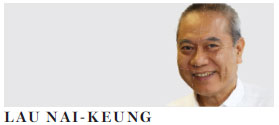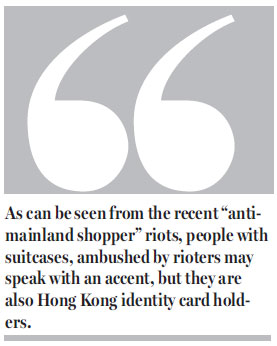Truth about parallel trading
Updated: 2015-03-17 09:18
By Lau Nai-keung(HK Edition)
|
|||||||||
Hong Kong has probably been a hub for gray activities for centuries
Chief Executive Leung Chun-ying went to the two sessions in Beijing hinting that a solution on restricting the ability of Shenzhen traders to visit Hong Kong was close.
However, he returned empty handed. Certain commentators have suggested Shenzhen and Guangdong intervened to prevent the central government from giving the SAR a solution. But Hong Kong can be sure that there is little to link our present predicament with parallel trading (as our politicians understand the concept).
According to Wikipedia, parallel trading in Hong Kong can be traced back as far as the end of the Qing Dynasty (1644-1911). From then until the 1920s-30s, the online encyclopedia says about 3,000 parallel traders were active around the Lo Wu control point. They mainly traded Western medicines and milk formula to the mainland, and rice and other products to Hong Kong.
But you don't have to go back to the Qing Dynasty. Two years ago in March 2013, the Customs and Excise Department (C&ED) estimated there were about 20,000 parallel traders plying the Hong Kong-Shenzhen border, and 60 percent of them were Hong Kong people. The C&ED also produced amazing data saying that of the 300 or so people who were recorded to have traveled back and forth from the two cities within a week, more than 90 percent were Hong Kong residents. In 2012, 8,000 parallel traders were prosecuted. Half of them were Hong Kong people. In the same 2013 news report, customs officials revealed that one Hong Kong person, believed to be a parallel trader, travelled to Shenzhen 26 times in one day.
What all this tells us is that if parallel trading (as opposed to Hong Kong simply having too many visitors) really is the issue, the city at least has to restrict the mobility of Hong Kong traders as much as their Shenzhen counterparts.
Back in 2013, Michael Tien Puk-sun deputy chairman of the New People's Party, was reported as expressing doubts on the effectiveness of introducing restrictions on the number of visits by mainland visitors.
But let's face it: Hong Kong has always been a center for parallel trade activities. Think of the iPhone frenzies, which happen whenever Apple release a new product. How many Hong Kong people are directly or indirectly involved in this trade? When the iPhone 6 was released last year, stores in Mong Kok's Sin Tat Plaza were offering HK$10,000 to those willing to re-sell the latest model. This was almost twice the official local price of HK$5,588. The phones were then re-sold, many to the mainland.
When the iPhone 6 was first launched in Hong Kong, Michael Grothaus, writing for immersionist lifestyle magazine Vice, reported that Kai Chiu Road was so full of iPhone resellers that it was like the ground zero of Asia's Apple gray market. When he went to Kai Chiu Road, where an Apple Store is located, Grothaus noted "a mix of Chinese capitalists, some Apple employees in denial, and a number of locals scalping (reselling at a higher price) to keep their families fed".
Grothaus saw the issue for what it was. Hong Kong is not only a national gray market, but a regional one. People from different backgrounds are involved in this business, but many are locals. This should shock nobody. This is almost the definition of Hong Kong.
Hong Kong people often say food safety and other quality issues are the root causes of parallel trading. But in the case of iPhones, it is merely greed. Expunging mainland participants from this gray market will not reduce parallel trading activities. It will only make local players richer. Will fewer passengers and suitcases be seen on trains? No. As can be seen from the recent "anti-mainland shopper" riots, people with suitcases, ambushed by rioters may speak with an accent, but they are also Hong Kong identity card holders.


(HK Edition 03/17/2015 page10)